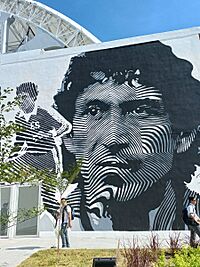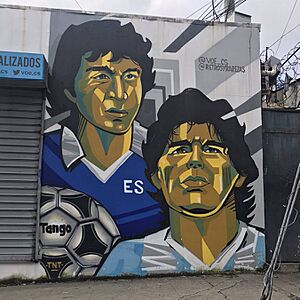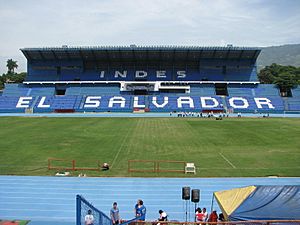Mágico González facts for kids

González mural at the Estadio Jorge "El Mágico" González
|
|||||||||||||||||||||||||
| Personal information | |||||||||||||||||||||||||
|---|---|---|---|---|---|---|---|---|---|---|---|---|---|---|---|---|---|---|---|---|---|---|---|---|---|
| Full name | Jorge Alberto González Barillas | ||||||||||||||||||||||||
| Date of birth | 13 March 1958 | ||||||||||||||||||||||||
| Place of birth | San Salvador, El Salvador | ||||||||||||||||||||||||
| Height | 1.73 m (5 ft 8 in) | ||||||||||||||||||||||||
| Position(s) | Forward, attacking midfielder | ||||||||||||||||||||||||
| Senior career* | |||||||||||||||||||||||||
| Years | Team | Apps | (Gls) | ||||||||||||||||||||||
| 1975–1976 | ANTEL | 45 | (13) | ||||||||||||||||||||||
| 1976–1977 | Independiente Nacional | 32 | (7) | ||||||||||||||||||||||
| 1977–1982 | FAS | 63 | (39) | ||||||||||||||||||||||
| 1982–1984 | Cádiz | 75 | (29) | ||||||||||||||||||||||
| 1985 | Valladolid | 9 | (2) | ||||||||||||||||||||||
| 1986–1991 | Cádiz | 119 | (28) | ||||||||||||||||||||||
| 1991–1999 | FAS | ||||||||||||||||||||||||
| Total | 343+ | (118+) | |||||||||||||||||||||||
| International career | |||||||||||||||||||||||||
| 1976–1998 | El Salvador | 62 | (21) | ||||||||||||||||||||||
|
Medal record
|
|||||||||||||||||||||||||
| *Club domestic league appearances and goals | |||||||||||||||||||||||||
Jorge Alberto González Barillas (born 13 March 1958) is a famous Salvadoran former footballer. He is widely known as El Mágico ("The Magical One" or "The Wizard"). He mostly played as a forward.
During his 24-year career, he played mainly for FAS in El Salvador and Cádiz in Spain. Many people consider him the most talented footballer ever from El Salvador. He is also seen as one of the greatest players from the CONCACAF region.
González played for the El Salvador national team for over two decades. He was part of the team that played in the 1982 World Cup. He also participated in the 1998 Gold Cup.
Contents
Club Career Highlights
Starting His Football Journey
González was born in San Salvador, El Salvador. He started his professional football career in 1975. He played for teams like ANTEL and Independiente. After two seasons, he joined FAS in El Salvador's top league.
While playing in El Salvador, people called him Mago. When he moved to Spain, his nickname changed slightly to Mágico. A journalist named Francisco "Paco" Perea helped make this new name popular.
Playing for Cádiz
In 1982, both Atlético Madrid and Cádiz wanted González to join their teams. Even though Atlético Madrid was a bigger club, he chose to sign with Cádiz. His first game in Spain was a friendly match. His official league debut was on 5 September 1982, where he scored a goal.
He quickly became a fan favorite because of his amazing moves and goals. Fans loved his skills so much that they often overlooked his unique habits. In his first season, he played 33 games and scored 14 goals. His team, Cádiz, was promoted to La Liga, Spain's top division.
In 1983 and 1984, Cádiz visited the United States. González was a big attraction. In 1984, Barcelona and their star player Diego Maradona joined them. Maradona later said that González was "without a doubt amongst the greatest ten players I have ever seen play in all my life."
González's debut in Spain's top division was on 11 September 1983. Cádiz was relegated back to the second division that season. Despite this, big clubs like Paris Saint-Germain and Italian teams wanted to sign him. However, González decided to stay with Cádiz.
He briefly moved to Real Valladolid in January 1985. He played only nine games there because he preferred a different lifestyle. He returned to Cádiz exactly one year later. His contract was set up so he was paid per game played.
Under coach Víctor Espárrago, González shined again for Cádiz. He played four more seasons in the top division. He scored 58 goals in 194 league games for Cádiz. He left the club on 6 June 1991, when he was 33 years old.
Later Career and Tributes
After leaving Cádiz, González returned to El Salvador and rejoined FAS. He played for FAS until 1999, when he retired from playing. He then worked as an assistant coach in Houston, Texas, for a short time before returning to El Salvador.
In 2001, Cádiz held a special match to honor González. The money raised went to help victims of an earthquake in El Salvador. In 2003, the Salvadoran government gave González their highest honor, the Hijo Meritísimo. They also renamed the national stadium, Flor Blanca, after him. It is now called the Estadio Jorge "El Mágico" González.
On 28 August 2004, another tribute match was played in El Salvador. It was held at the Mágico González Stadium. The match was between a team of international stars and a team of former FAS players. González played for both teams and scored three goals.
International Football Career
Many experts believe that if González had been from a bigger football country like Argentina or Brazil, he would be ranked among the world's best. He earned his first of 62 caps (appearances) for El Salvador on 1 December 1976. This was a FIFA World Cup qualification match against Costa Rica.
He played a key role in helping El Salvador qualify for the 1982 FIFA World Cup. This was only the second time in history El Salvador reached the World Cup. He played in all three group-stage matches, including a game against Hungary.
González played in 31 World Cup qualifying matches for his country. He scored 21 goals in international games.
Playing Style and Influence

González was a slim and very creative forward. He had amazing ball control, technical skills, and dribbling abilities. He was also known for his quick feet and using many tricks and feints. These included the flip flap, the Cruyff turn, and the step over. He was very accurate with the ball and fast when he had possession.
He is widely considered the greatest Salvadoran footballer of all time. Many also see him as one of the best Latin American footballers ever. In 1999, he was named his nation's Player of the Century.
González was a versatile forward. He could play as a winger or as a second striker. Sometimes, he played as a centre-forward or as a playmaker in the number 10 role. He even played as a midfielder sometimes. He often wore the number 11 shirt. His unique playing style inspired Diego Maradona. Maradona greatly admired González, calling him one of the ten best players he had ever seen. Maradona even said, "we, in training, always tried to imitate him [González], but couldn't."
Personal Life
González grew up in a family with limited money in San Salvador. He was one of seven brothers and had one sister. His older brother, Mauricio, was also a well-known footballer in El Salvador.
Mágico married Ana María Ruano, whose father, Alfredo Ruano, was another Salvadoran football legend. His son, Rodrigo (born 1981), played in El Salvador's top football league.
Honours and Achievements
FAS
- Primera División de Fútbol de El Salvador: 1977–78, 1978–79, 1981, 1994–95, 1995–96
- CONCACAF Champions League: 1979
El Salvador
- Central American Games: 1977
- CONCACAF Championship runner-up: 1981; third place: 1977
Individual Awards
- CONCACAF Team of the Century: 1998
- Best Salvadoran player of the 20th century by the International Federation of Football History & Statistics: 1999
- Cádiz CF Hall of Fame: 2001
- El Salvador Hall of Fame: 2004
- Football Hall of Fame: 2013
See also
 In Spanish: Mágico González para niños
In Spanish: Mágico González para niños


